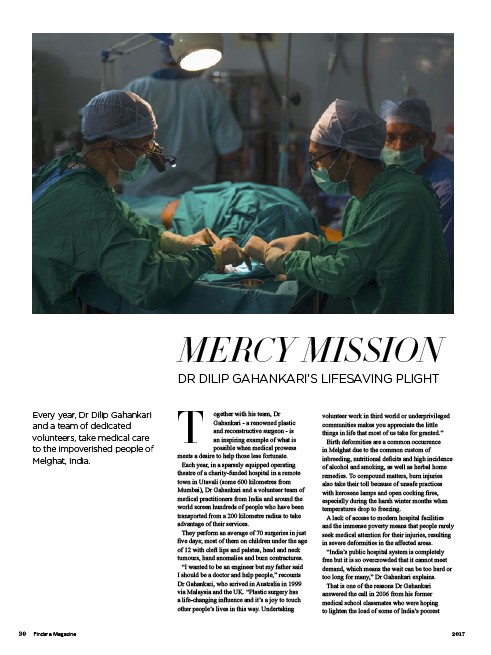
MERCY MISSION
DR DILIP GAHANKARI’S LIFESAVING PLIGHT
ogether with his team, Dr
Gahankari - a renowned plastic
and reconstructive surgeon - is
an inspiring example of what is
possible when medical prowess
meets a desire to help those less fortunate.
Each year, in a sparsely equipped operating
theatre of a charity-funded hospital in a remote
town in Utavali (some 600 kilometres from
Mumbai), Dr Gahankari and a volunteer team of
medical practitioners from India and around the
world screen hundreds of people who have been
transported from a 200 kilometre radius to take
advantage of their services.
They perform an average of 70 surgeries in just
five days; most of them on children under the age
of 12 with cleft lips and palates, head and neck
tumours, hand anomalies and burn contractures.
“I wanted to be an engineer but my father said
I should be a doctor and help people,” recounts
Dr Gahankari, who arrived in Australia in 1999
via Malaysia and the UK. “Plastic surgery has
a life-changing influence and it’s a joy to touch
other people’s lives in this way. Undertaking
Every year, Dr Dilip Gahankari
and a team of dedicated
volunteers, take medical care
to the impoverished people of
Melghat, India.
volunteer work in third world or underprivileged
communities makes you appreciate the little
things in life that most of us take for granted.”
Birth deformities are a common occurrence
in Melghat due to the common custom of
inbreeding, nutritional deficits and high incidence
of alcohol and smoking, as well as herbal home
remedies. To compound matters, burn injuries
also take their toll because of unsafe practices
with kerosene lamps and open cooking fires,
especially during the harsh winter months when
temperatures drop to freezing.
A lack of access to modern hospital facilities
and the immense poverty means that people rarely
seek medical attention for their injuries, resulting
in severe deformities in the affected areas.
“India’s public hospital system is completely
free but it is so overcrowded that it cannot meet
demand, which means the wait can be too hard or
too long for many,” Dr Gahankari explains.
That is one of the reasons Dr Gahankari
answered the call in 2006 from his former
medical school classmates who were hoping
to lighten the load of some of India’s poorest
T
30 Pindara Magazine 2017